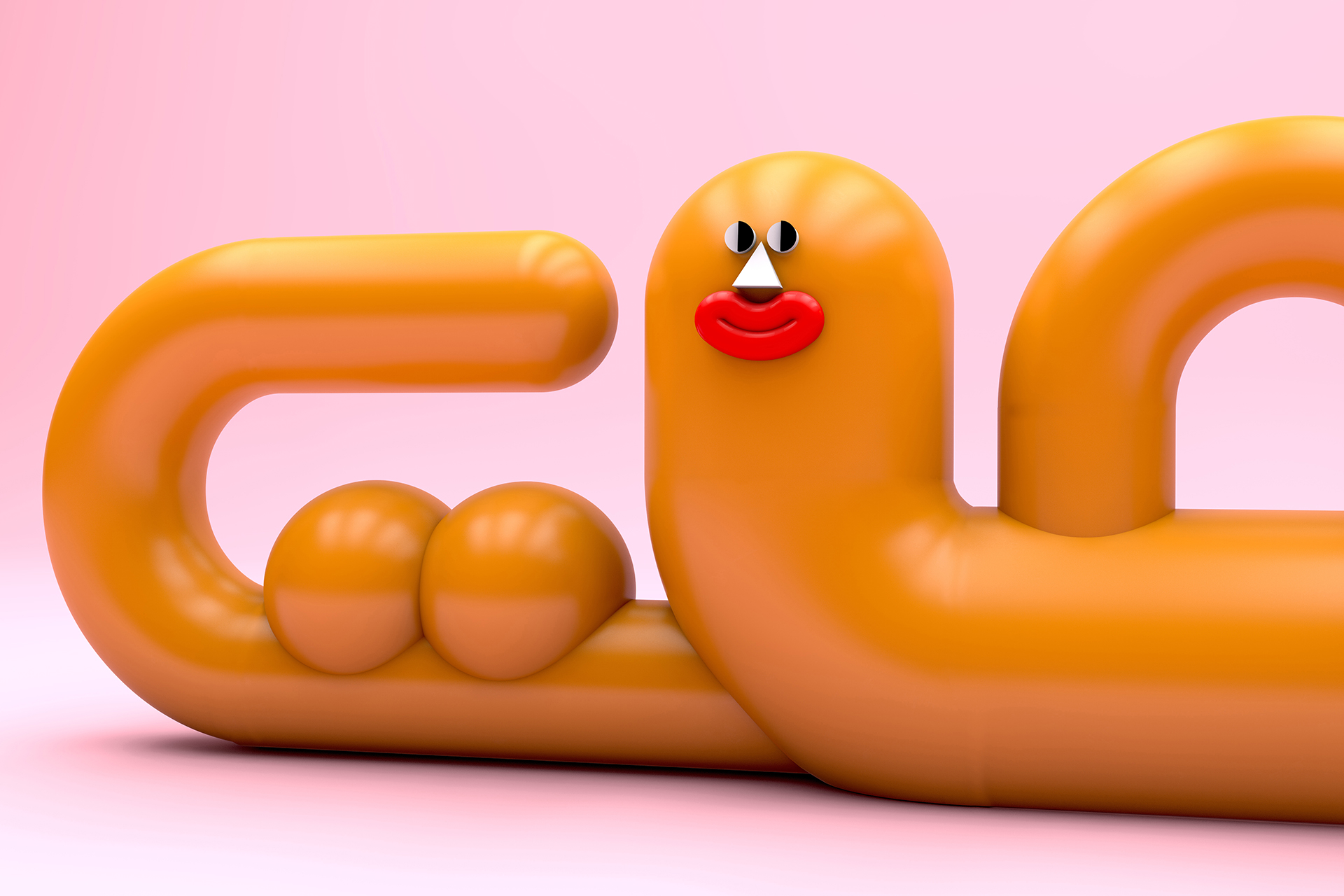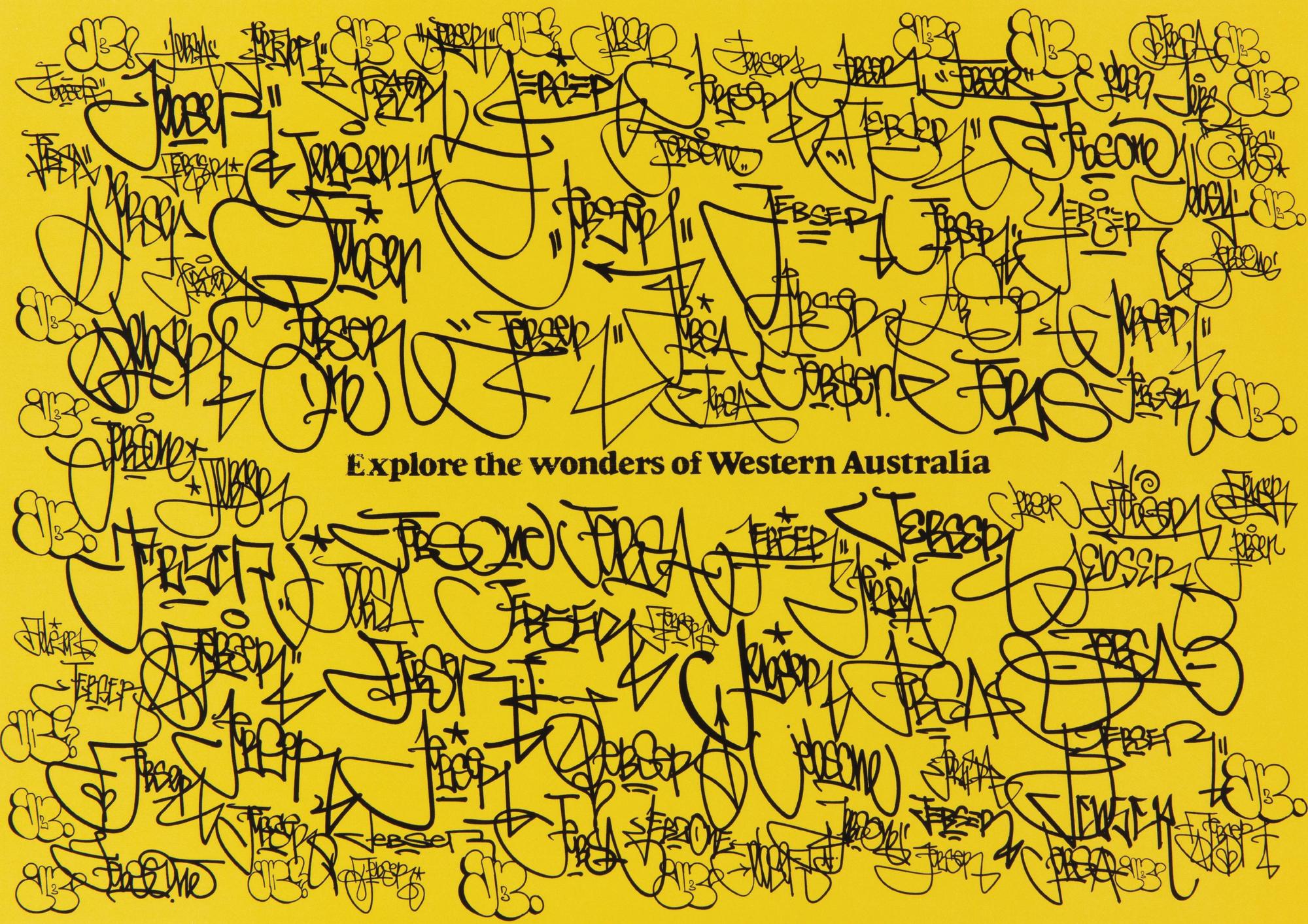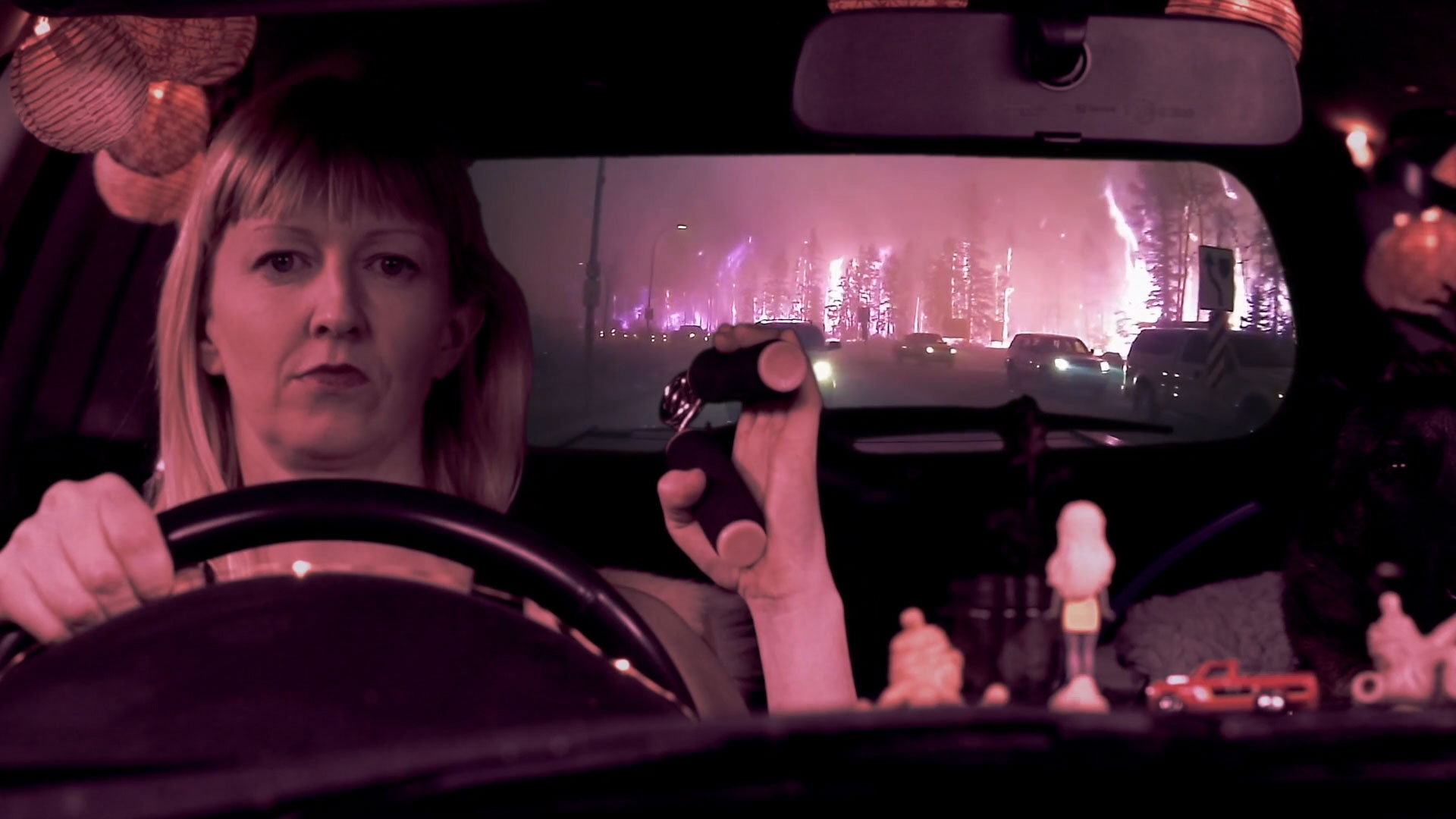Collective Ground: Grounding Effects
The first exhibition of Aboriginal and Torres Strait Islander works acquired through AGWA’s COVID-19 stimulus package, Collective Ground tells a story that transcends the power of individual artworks.
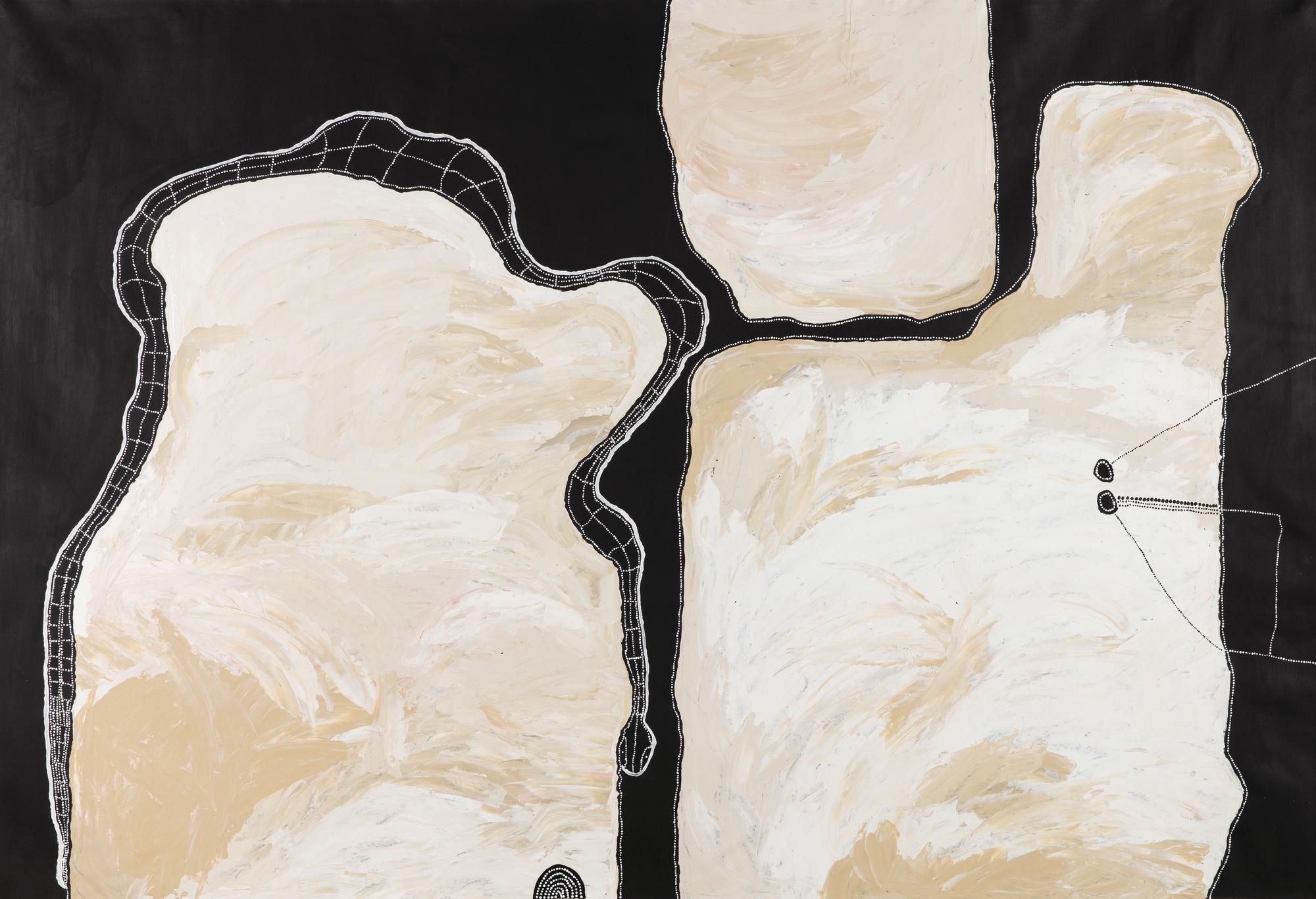
Timo Hogan Lake Baker 2020. Acrylic on linen, 197 x 288 cm. State Art Collection, Art Gallery of Western Australia. Purchased through the Art Gallery of Western Australia Foundation: COVID-19 Arts Stimulus Package, 2020. © Timo Hogan/Copyright Agency Ltd.
GREAT WORKS OF ART can exert a singular power. But in Collective Ground, objects speak to and of each other. Individual stories are part of a greater whole. The new exhibition, showing for a limited time at AGWA, is curated by Tui Raven, a Yamaji and Noongar Yorga curator who grew up between city and Country. Although it features works by renowned artists like Donny Nyorna Woolagoodja, Lily Long and the Tjanpi Desert Weavers, Collective Ground also celebrates connections that transcend culture, place and time.
“My focus as a curator is looking at collections and working with communities to try to understand what these objects say as a group and not just by themselves,” Raven says. “The works [in the show] are from all over Western Australia, from the Kimberley region to the Goldfields, but even using the term ‘regions’ is foreign to me. It’s a very local government way of looking at Country.” Pausing for a moment to collect her thoughts, she adds: “I try to look at what each work means as part of a body of work, and what underlying stories it is trying to tell us.”
In this region bordered as Western Australia, landscapes blur into each other. Drive along the southwest coast and ancient granite boulders give way to towering Karri trees. Head far enough north and spinifex grass in the desert heralds the blue of freshwater lakes and wetlands.
“When I look at a work I can say, ‘This looks like it’s from the Martu area’, but Martu country takes in the Kimberley, the Pilbara and the Western Desert,” Raven explains.
Collective Ground brings together over 60 works drawn from a collection of 129 pieces by Aboriginal and Torres Strait Islander artists. The works were acquired through a $1.5 million stimulus package announced by the AGWA Foundation at the start of the pandemic.
In the absence of any national stimulus for artists at that time, the Foundation took from its own funds to directly support living artists; an important targeted acquisition program that enabled the State Art Collection to comprehensively capture a moment in time.
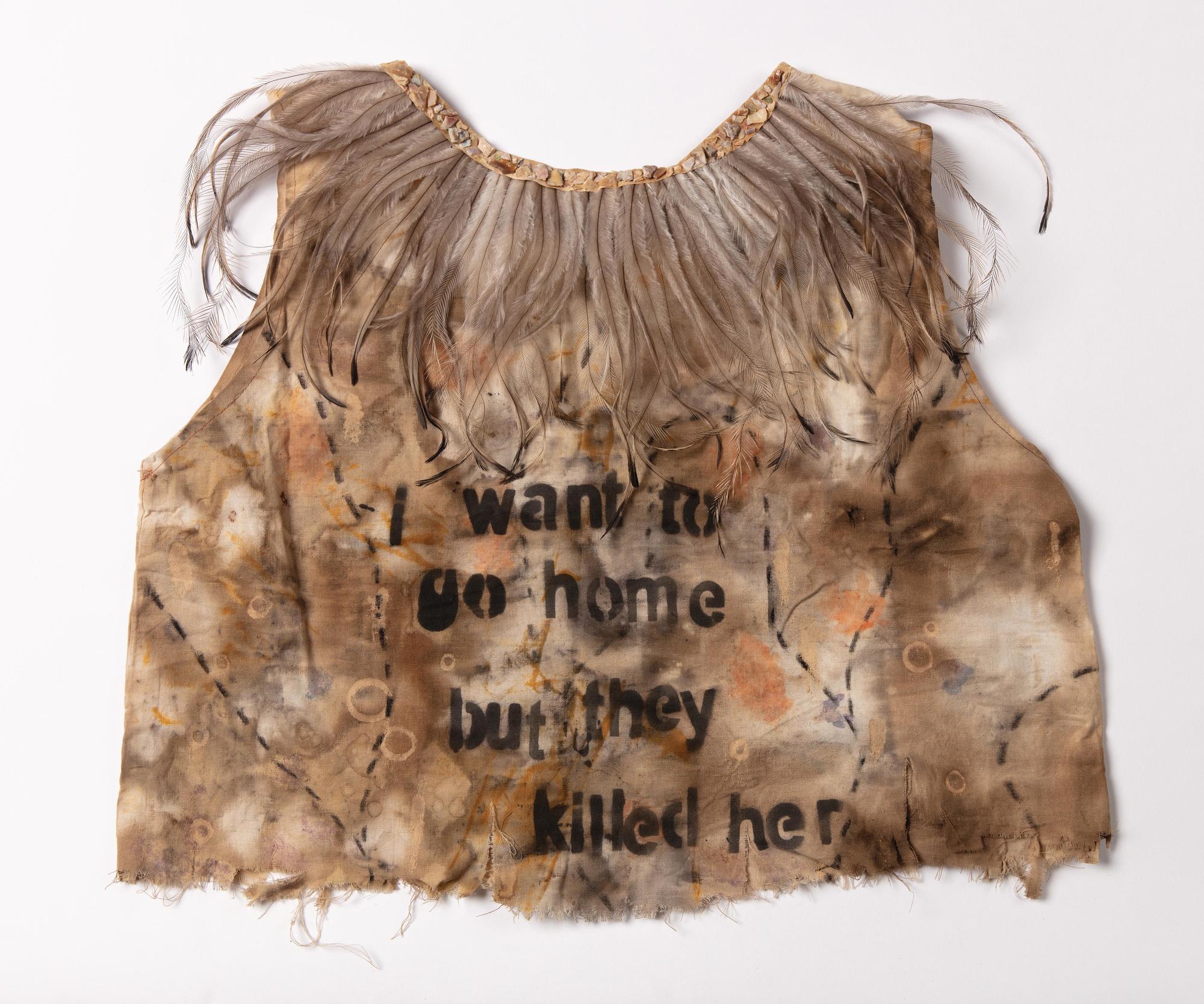
Yabini Kickett I want to go home but they killed her 2020. Eco/rust dyed cotton, emu feather, opal, white ochre, charcoal, spray paint, Pycnoporus coccineus and Eremophlia staining and photographic print, 54 x 50 cm. State Art Collection, Art Gallery of Western Australia. Purchased through the Art Gallery of Western Australia Foundation: Covid-19 Arts Stimulus Package, 2020.
There are installations by the Maruku Arts Women’s Collaborative, a group including Angelina Woods, Cynthia Burke, Julie Porter, Kathleen Kanta Donegan and Lalla West. Maruku has been active since the 1980s on the lands of the Anangu, where Western Australia converges with South Australia and the Northern Territory.
Pitjantjatara artist Timo Hogan’s Telstra Award-winning work Lake Baker hangs in monochrome, telling a creation story connected to the sacred place after which it’s named. Hogan lives and works in Tjuntjuntjara, one of the most remote communities in Australia, situated more than 600km northeast of Kalgoorlie.
There are intricate charcoal studies by Mervyn Street, a senior Gooniyandi artist who was born on Louisa Downs Station, midway between Halls Creek and Fitzroy Crossing. Street’s work, which spans painting, illustration and carving, chronicles his memories. In Black and White Brothers (2020), two figures—one Indigenous, the other white—stand side by side casting long shadows, their lives playing out in tandem.
When Money Went Missing From the Ration Store Tin (2020) tells a darker story. An authority figure hulks over a station hand, wielding handcuffs. A police vehicle commands the frame.
“It’s about taking stock and re-looking at Western Australia,” Raven says. “We live in this amazing place, but we don’t know anything about it.”
Yabini Kickett, a Ballardong and Whadjuk woman, often makes art about a longing for places that have disappeared because of ecological destruction, an ongoing effect of colonisation. Here, her 2020 piece I want to go home but they killed her takes the form of an earth-coloured top adorned with feathers. The title is stencilled across the front in black. So often, we carry our homes with us. But what happens to our bodies, the work asks, when the places we’re from are threatened?
Raven tells me that Collective Ground is about better understanding our relationship with the place we’re standing—even if that sparks tensions or contradictions.
“The pandemic has made us take a step back and take a look at where we actually are physically, and what we have to face,” she says. “We started by being in this idea of the world where we could go anywhere we wanted, this very wide-open view, and then being contained in lockdown. So it’s about taking stock and re-looking at Western Australia. We live in this amazing place, but we don’t know anything about it.”
Peggy Griffiths was born in Miriwoong country in the East Kimberley, a place of red earth, tidal rivers and waterways. “I was born in Newry Station near Kununurra and I started carving boab nuts when I was young,” she says. “Then I started painting.” At Newry Station, she witnessed her family being taken away. She was shaped by the stories of her grandfather Charlie Mailman. “I’ve got to keep my painting alive,” she says.
Griffiths is acclaimed as a performer and dancer. Collective Ground will feature her Legacy Dress II (2020), a dramatic, ruffled garment that speaks to traditions such as ceremonial body design and cultural adornment.
“Each layer tells a story about bush tucker and medicine,” says Griffiths, who has been working with Waringarri Arts since 1994. “River grasses and barramundi, water holes and country, boab nuts, and sugar bag or wild honey.”
She made the dress, which won a 2020 National Indigenous Fashion Award, alongside her granddaughters.
“I want people to know that we are continuing our culture,” she says. “And younger artists are carrying on the knowledge.”
Colin Walker, AGWA’s director, believes that 21st-century museums should foreground this culture and knowledge. He points out that the gallery is located on the site of the state’s first colonial land grab.
“So, we have a really difficult history of the site,” Walker says. “White people came in and drew pictures and said ‘this land is now ours’.”
For Walker, the stimulus package and Collective Ground are about finally making First Nations voices central to the gallery.
“We decided because of the importance of Aboriginal art centres and Aboriginal communities that we would just commit to purchasing art from every art centre in the state,” he says. “Our Aboriginal and Torres Strait Islander Collections gallery was previously one of the smallest spaces but we’ve now moved it to the ground floor, our largest gallery space. It’s really important that First Nations people are represented first. Everything has to stem from that.”
Curating a show that puts First Nations voices first, Raven says, isn’t just about hanging works in a space. It’s also about respecting protocols and traditions.
Curating a show that puts First Nations voices first, Raven says, isn’t just about hanging works in a space. It’s also about respecting protocols and traditions.
“[Some works] I only understand at surface level,” she says. “The only way I would understand, deeply, what those paintings mean is if I was from that community.”
She divided the gallery space to reflect the geography of Western Australia. She separated men’s and women’s stories into two moodily lit presentations, imagined as a pair of constellations.
“The Pleiades or The Seven Sisters is for the women and the Southern Cross is for the men,” she says. “They both sit within constellations that are broadly about Country or contemporary issues, such as the 1905 Act and colonisation.”
Collective Ground includes Kungkarungkalpa (2020), a dazzling painting by the Spinifex Women’s Collaborative, who are from Spinifex Country in the Great Victoria Desert. The work recreates the Seven Sisters Creation story, about seven sisters who make an epic voyage while fleeing a man, in a kaleidoscope of orange, yellow and blue.
Songlines, Raven says, criss-cross the state.
“Individually, the works are quite powerful,” she says. “But in terms of putting them together, I want to make people understand that communities, while they may be separate, have Dreamtime stories that run through them. There are works from the Pilbara that connect all the way down to the southern part of the Western Desert.”
Raven jokes that she thought of the name for the show when she woke up singing rock band Goanna’s 1982 hit Solid Rock. “I know it sounds funny but it’s about us living on Country,” she smiles. There are stories we share and those we are still to reckon with. But the ground beneath us is a fitting metaphor for the places to which we’re bound.
“A thing I’d like to point out is that we are all connected—not just Aboriginal people. We are all in it together. So, it’s about readjusting to that fact and taking pride in that.”
This article was first published in the print publication The View From Here in October 2021 under the title Grounding Effects.
